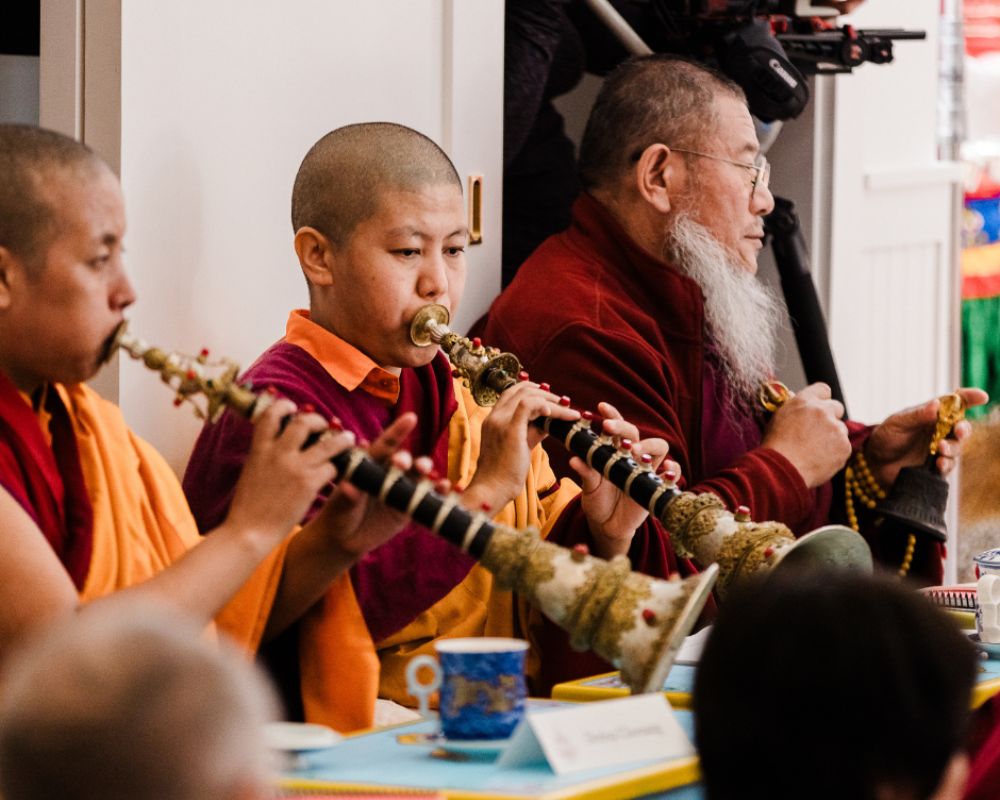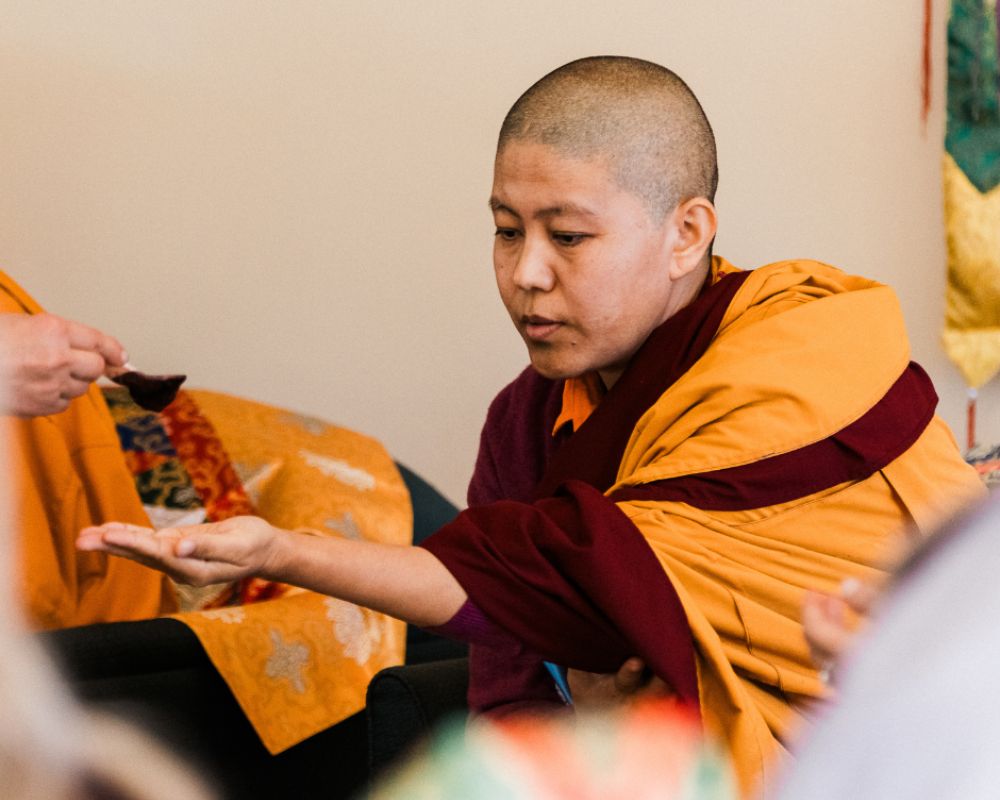Early Life as a Tibetan Refugee
Long before Jetsünma was born, her mother, Pema Tsedon, was faced with an agonizing decision: flee Tibet or face persecution from China. Her mother fled to India and made a new home in the Mainpat Tibetan Refugees Community in Chattisgarh state, where Jetsünma was later born and raised.
When Jetsünma was an infant, H.E Beru Khyentse Rinpoche and a group of Kagyu masters recognized her as a reincarnation of Gelongma Khehog Palmo (Frieda Bedi), a women’s rights activist, professor, and one of the first Westerners to be ordained as a Tibetan Buddhist nun. It was then that Jetsünma’s mother was faced with another difficult decision: she could place her baby in a nunnery as soon as possible or try to keep the reincarnation a secret.
Pema opted to keep the reincarnation as Gelongma Khehog Palmo a secret from Jetsünma. Though Pema is a devout Tibetan Buddhist, she wanted Jetsünma to receive a full education and to have a choice about following the monastic path. At that time, women weren’t recognized as lamas or given any positions within Buddhism, so Pema could not accept the idea of giving her baby to a nunnery.
Thus, Jetsünma led a normal childhood. She shared that attending boarding school far away from home is quite routine for Asian children. While Jetsünma’s mother didn’t want to give her baby to a nunnery, she did want her to receive an education, so at age 8, Jetsünma went to a boarding school in Nepal. After three years of boarding school, she attended the Tibetan Government School, a school created by the Indian government exclusively for Tibetan refugees. Initially, becoming a nun wasn’t a thought in Jetsünma’s mind; as she says, she was “just a normal high schooler.”

That was until 10th grade when an elderly nun and administrator at Jetsünma’s high school approached Jetsünma and asked her to be a caretaker at the Tilopa Drupgyuling Nunnery, the first nunnery created for exiled Tibetan Buddhists. In one of many instances where Jetsünma bravely advocated for herself, she hesitantly replied, “I need time to think about that. I cannot decide right away.” The nun agreed to give her time and gave her a small book called Last Days of Sister Palmo, a short biography of Gelongma Khehog Palmo (Frieda Bedi).
That small book changed the course of Jetsünma’s life. Knowing that this decision would change her life, Jetsünma took months to decide. Her future became clear as she read and contemplated the Last Days of Sister Palmo. “I felt the calling. I have to carry on the work from my past life. I have to help spread Buddhism in the East and West.”
Education was important to Jetsünma, so she agreed to go to the nunnery only if she could still finish school. She became a nun in 11th grade and completed high school in full nun attire.
As she says, “The rest is history.”

The Monastic Life
After high school, Jetsünma spent three years at Tilopa Drupgyuling Nunnery and another nine years studying Buddhist philosophy at Tsogyal Namdrol Shedrub Tharjayling Nunnery. While Jetsünma was academically successful, she was surprised to find herself fraught with doubt in the monastic life.
“In my teenage mindset, the concept of gender equality was strong and natural because I had never encountered gender segregation in my school or my family. Seeing the imbalances in this religious community regarding education, position, and leadership was challenging.
“I thought, ‘Why can’t an ordinary female who’s realized and learned be acknowledged as a lama and a teacher by the Buddhist religious and lay community? Why are the qualifications only limited to a female who is a wife, sister, niece, daughter, etc. of a male leader? Why can’t an accomplished female practitioner rise solely on her merits?’
“At that time, I thought because I was Buddhist, I should be filled with more love and compassion than non-practitioners. I thought, ‘How can you teach people love and compassion when you are not even working on that?’ My nun friends were fine and submissive. They didn’t see it the same way. I thought, ‘Maybe I have a negative perspective. Maybe I am a skeptic.’ It was hard for me to digest these gender imbalances. I didn’t see the practice of equanimity happening around me, which should be the priority regarding the bodhisattva path.
“So I thought, ‘Okay, I will graduate for now. But then I will head out to a retreat center and try to find the truth of teachings by myself.’ I did enough theoretical studies on the truth, but then my question was still unanswered, and my doubt wasn’t cleared, so I planned to find the truth through meditation.
“They wanted me to stay at Tsogyal Namdrol Shedrub Tharjayling Nunnery to help with administration and become a teacher, but I declined. I thought, ‘If I don’t find the truth, then there is no meaning in becoming a nun or even being a Buddhist. So, I finished my last exam and left that afternoon.”
During that time, she returned to one of the basic perspectives of the Vajrayana path: that everyone is a deity.
“So, in terms of a deity, males and females are the same. It proved that what I saw practically was not the right thing. So whatever imbalances I see nowadays, it’s because of social pressure, environmental influences, and culture. Those aren’t the real practices of a Buddha.”

Three-year Retreats in Tibetan Buddhism
With restored faith and clarity of her path, Jetsünma completed her three-year retreat at Kusum Khandroling Retreat Center.
For Jetsünma, her greatest challenges came before her three-year retreat—the years of wrestling with doubt. When asked about the challenges of her retreat, she replied,
“It was not challenging at all because I felt thirsty and hungry from the time I entered the retreat. I had to validate the Buddha’s real teachings. At that time, I was ready to receive teachings from the Vajrayana Path, a branch of Mahayana Buddhism.
“I kept on receiving all of the teachings. There were usually four sessions a day, and then I would contemplate the teachings again and do some type of analytical meditation by myself. During my time there, I concluded that the imbalances I saw were not real [Buddhism]. Whatever teaching I received, I always analyzed first to make sure it promoted oneness and equality; only then would I embrace the practice.”
After she completed her first three-year retreat, Tulku Sangak Rinpoche awarded her the title Jetsünma, which means venerable: exalted in both the studies and practices.
The title Jetsünma carries important responsibilities. When a practitioner is appointed Jetsünma, they are required to take action for the welfare of others. Tulku Sangak Rinpoche asked her if she was ready to be a teacher in the West, specifically in Montana, Santa Fe, and California.
She explained that she wanted more time in retreat before she started teaching. So, she asked him if she could have four more years of retreat to stabilize her practice. He agreed. After that four-year retreat, she asked for two more years. Then finally, after nine years in total, she felt ready to be a teacher in the West. “I wanted more than just theoretical knowledge. I wanted to be able to teach from my own experience.”
She certainly gained that experience. After her three-year retreat, she became a Vajra Master from 2009 to 2012 and a Retreat Master from 2012 to 2017. A Vajra Master is a teacher with spiritual authority empowered to transmit the Vajrayana teachings, related practices, and group rituals. Retreat masters provide practice and ritual instruction within the context of a three-year retreat.
Jetsünma’s Journey to the West
At that time, Jetsünma had some English speaking skills, but she wanted “full command of my English so that I can deliver the message that is inside me to the student. If there is a language barrier, then whatever I have inside will remain inside, and I will only use the words I know.”

Tulku Sangak Rinpoche told her she could sit with a translator to learn English. That wasn’t what she had in mind, so she said, “I’m not talking about just translating. That is only one aspect of [the] English. I want to explore the culture and mentality of Western people. I want to go to college or university.”
She asked for a two-year sabbatical, and he replied, “Go and learn whatever you can for two years and then come back.”
Her parents lived in Boston, and she joined them, knowing there were great schools there. Given Jetsünma’s tenacity and passion for learning, it’s unsurprising that while new to the United States, she began her education at Harvard.
Unfortunately, Harvard would not accept her high school diploma, as it was not from a school they considered internationally accredited. So, she could only attend one semester as a non-degree-seeking student. And that’s what she did. From her desire to understand people who were different from her, she studied Atheism.
Simultaneously, she studied English, sociology, psychology, medieval history, and world religions. When asked about her favorite subject, she smiled and said, “I loved all of them. They are all indispensable subjects that complete each other.”
As far as how these topics impacted her as a teacher of Tibetan Buddhism, she replied, “I learned about atheism, and that helped me understand the perspective of people who are non-religious. I also gained more understanding of other religions. In the natural state of our mind—the true essence of an uncorrupted mind—religious doctrine and rules do not exist.”
One difference that she noticed was that many of the religions she studied labeled every act, thought, and result as a sin or reward, pure or profane, acceptance or rejection, hell or heaven on the ultimate level. However, in Buddhism, religious doctrine, distinction, and rules do not exist in the natural state of mind–the true essence of an uncorrupted mind.
“In most religions, we have positive and negative aspects of thought and conduct. Such things don’t exist in a natural state of mind because their authenticity cannot be corrupted by contrivance and modification. In a natural state of mind, there’s no use in labeling your thoughts and emotions as positive and negative or good and evil.”
After two years of studies, she understood Westerners better and felt comfortable with English. With that, she was ready to start teaching in the U.S.
Jetsünma’s Life as a Buddhist Teacher
Nowadays, Jetsünma’s home base is Montana, but she teaches in California, New Mexico, Nepal, India, and, as she says, “wherever I’m invited to teach.”
In the West, some of her teachings have specialized in grief and bereavement. However, her main goal is to be of service and to teach in a way that connects to her audience, whoever they may be.
“Whenever I’m invited to teach, I always ask, ‘What kind of audience do you have? What do they want to learn about? What are the stressors of their daily lives?’ I can teach from the conventional level and share specific teachings for practitioners.”
Advice for Fellow Doubters
Jetsünma exudes a welcoming warmth and would be a helpful resource for a Buddhist practitioner in a season of doubt. Doubt may be a normal part of any person’s journey on the Buddhist path. For those practitioners, Jetsünma had these words:
“There are two kinds of people–people like my nun friends who have no doubts and people like me who have an empirical mind. If the practitioner is going through what I went through, they should analyze and find the truth for themselves.

“At the end of the day, I felt like the doubt and suspicion I had helped. It urged me to find the truth. Sometimes the negative things become a positive impetus for finding good results. So now, I have full faith. My faith is not blind faith.
“I think I’m privileged to have both a skeptical and a fitful mind, which makes me really relatable as a teacher. If I’m a student and my teacher has never doubted their faith, and I’m having doubts, it’s hard to connect.”
In response to her own season of doubt, Jetsünma noted an upward shift in the number of female leaders in Buddhism.
“The imbalances are decreasing. We are advancing with time. I feel happy to see female teachers getting recognized. Nowadays, there are more women’s institutes with female teachers. And more female teachers are receiving the title of Khenmo, which is someone who has graduated and completed all of their [seminary] studies”.
Aspirations
Looking to the future, admirably, Jetsünma aspires to remain a flexible teacher who can teach to the masses.
“I don’t want to label myself as a teacher who only teaches serious practices for enlightenment. I also want to help people release themselves from the stresses of their daily lives.
“I think teachers are very important. Whether we are teaching at a university or teaching Buddhist practitioners, we are shaping students. My goal is to create more good people even if they don’t have the intention of enlightenment. When I teach to our nuns, I say, ‘I don’t know if you will be a nun for your entire life.’ And I always tell them, ‘We have to be good human beings, and we have to create good human beings, even if you decide to stop being a nun.’
“Buddhist or not, we are human, and the world always needs good humans.”
Throughout her journey, Jetsünma thought deeply about the kind of teacher she aspired to be. She took deliberate steps and made choices that allowed her to develop into the person she envisioned. For example, she requested more time to complete high school and took the time to analyze her beliefs and doubts. She recognized the importance of mastering English and stabilizing her practice before teaching in the West, so she wisely asked for more time. Ultimately, her dedication and commitment paid off as she became the female teacher she sought to be all along.
The Namchak Three-year Retreat Center is currently under construction. Click here to receive updates!
